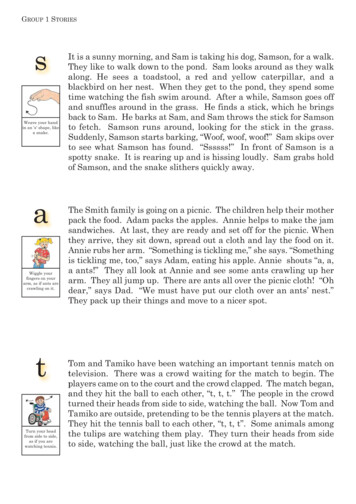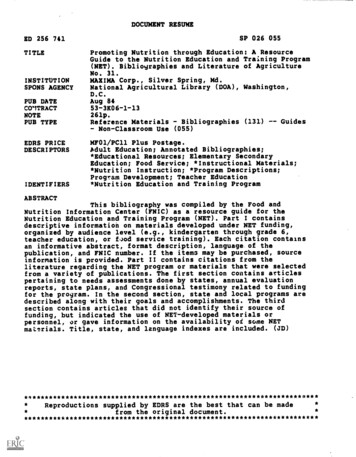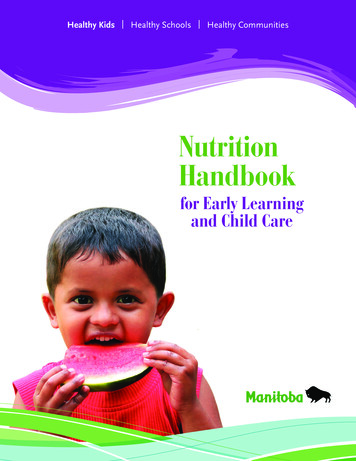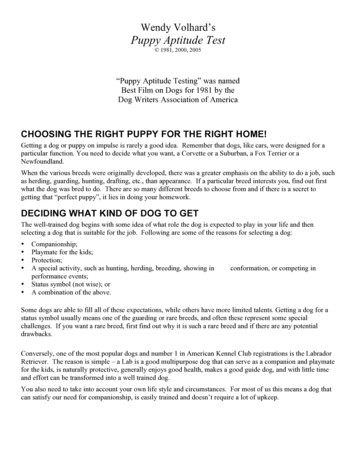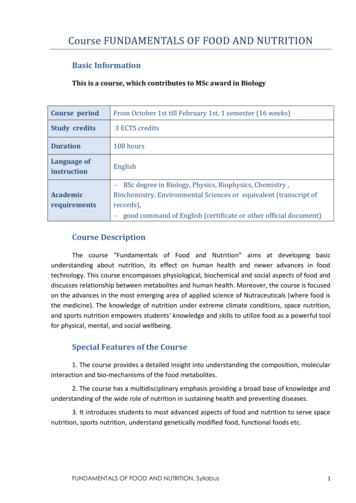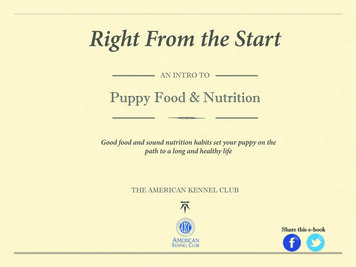
Transcription
Right From the StartAN INTRO TOPuppy Food & NutritionGood food and sound nutrition habits set your puppy on thepath to a long and healthy lifeTHE AMERICAN KENNEL CLUBShare this e-book
What’s Love Got to Do With It?Share this e-book
Before we get to the particulars of puppy nutrition, let’s first consider the mostcommon pitfall of canine feeding. In theory, keeping your growing dog properlynourished is simple: Serve sensibly sized portions of high-quality chow, avoid feeding“people food,” and keep snacks to a minimum. In practice, this is easier said thandone. The pleading gaze of a begging dog can be irresistible. This is no accident.During his long partnership with man, the dog has perfected cunning methods ofexploiting the human neurosis that associates food with affection. In prehistoric timessemi-domesticated canines first cultivated human beings as a food provider. As thetwo species grew closer, dogs modified begging behaviors to maximize results: Themore pathetic a dog seemed, the more scraps were tossed his way. Dogs have sincerefined this approach into a low-risk, high-reward hunting technique.!It’s a deceptive way to hunt, but don’t be fooled: Begging is not an emotional crisis or atest of your love. It’s what scientists might call an evolutionary survival strategy, orwhat the rest of us might call a scam. Allowing your dog to “guilt” you intooverfeeding him, or serving him a steady diet of table scraps in a misguided show ofaffection, can have harmful or even fatal results.!So don’t take it personally when the little con artist under the table goes into the oldwhimper-wheedle-and-whine routine. Simply ignore it, and find healthier ways ofbonding with your pet.!Otherwise, you risk loving your puppy to death.Share this e-book
The Feeding Foundation:Your Puppy’s First YearShare this e-book
6–12 weeksGrowing pups should be fed puppy food, a diet specially formulated to meetthe nutritional needs for normal development. Feeding adult food will robyour puppy of important nutrients. Four feedings a day are usually adequateto meet nutritional demands. Large breeds should be fed unmoistened dryfood by 9 or 10 weeks; small dogs by 12 or 13 weeks.!3–6 monthsSometime during this period, decrease feedings from four to three a day. Apup should be losing her potbelly and pudginess by 12 weeks. If she is stillroly-poly at this age, continue to feed puppy-size portions until body typematures.!6–12 monthsBegin feeding twice daily. Spaying or neutering lowers energy requirementsslightly; after the procedure, switch from nutrient-rich puppy food to adultmaintenance food. Small breeds can make the switch at 7 to 9 months;bigger breeds at 12, 13, even 14 months. Err on the side of caution: Better tobe on puppy food a little too long than not long enough.!After age 1, most owners feed adult dogs two half-portions a day.Share this e-book
Big Puppy, Little PuppyShare this e-book
There are general rules for feeding any puppy, but there are differences between small- andlarge-breed dogs. Each has special nutritional needs.!The range of sizes among dog breeds is greater than in any other animal. For example, a150-pound Newfoundland is 50 times the size of a 3-pound Pomeranian.!To put it in perspective, picture a 150-pound human being and then imagine a fully grownperson who weighs only 3 pounds!!Large-breed puppies will weigh more than 50 pounds when full-grown. It takes these bigguys about 18 to 24 months to reach their adult size. If they grow too quickly, they candevelop problems with their joints and bones. Reduced-calorie foods with less calcium helpsupport the proper rate of growth in large-breed puppies.!Adult dogs who weigh less than 20 pounds are considered small-breed dogs. Puppies ofthese breeds grow quickly and may reach adulthood at 9 months.!Share this e-book
Some dog-food companies make a mini-size kibble for small-breedpuppies because their mouths are so little. And because their tinystomachs don’t hold much, small-breed puppies require high-caloriefoods to provide them sufficient nutrition.!Also, small dogs need more calories to maintain body heat: Theyproduce less heat and radiate more of it from their skin than do largedogs.!But small-breed dogs tend to be more pampered and less active thanlarger breeds, so owners who feed a high-calorie food formulated forsmall breeds should be careful not to overfeed.!A number of companies have worked with canine-nutrition scientiststo develop special formulas for both large- and small-breed puppies.Share this e-book
What You Should KnowShare this e-book
! ! ! If your puppy occasionally skips a meal or picks at food, don’tworry. It could mean she is ready to eliminate a feeding orthat you have given her too much, in which case simplyreduce the quantity served.Most, but not all, dogs finish meals quickly. To discouragepicky habits, feed at regular times in regular amounts anddon’t leave food down for more than 10 to 20 minutes.Feeding your pup the moment you get home may encourageseparation anxiety. Play or grooming is a more positive wayto say hello.If you are working with your pup in treat-based training,adjust the amount you feed at mealtime accordingly.Whenever training with treats, keep the treat as small aspossible.Share this e-book
! ! ! ! When medically necessary, you can purchase canned or dry prescription dietsfrom veterinarians to feed dogs with kidney disease, heart disease, diabetes, andother serious conditions. These foods should never be fed without aprescription.Some vitamin or mineral supplements, when used incorrectly (such as extracalcium given to a large-breed dog on a good diet), will do more harm thangood.Before making a major change in your dog’s diet, consult with your veterinarianand, when possible, the breeder. Once the formula is chosen, stick with it.Sudden changes in food may cause digestion problems.Small portions of carrot or apple chunks are healthful low-calorie snacks mostdogs love.Fresh water should be available at all times. During the summer months,consider setting up multiple indoor/outdoor water stations. To avoid a buildupof bacteria, wash the water bowl daily.Share this e-book
What You Should DoShare this e-book
! Chart your puppy’s condition ! ! ! ! A young dog carrying too much weight has an increased risk oforthopedic problems, due to stress on immature joints.Obesity can also lead to diabetes, diseases of the heart and otherorgans, and general lethargy.There are growth-and-weight charts available in print and online.Weigh the puppy weekly and record his progress, comparing him tobreed-appropriate weight charts. Adjust his food intake to achieve anaverage rate of growth.Weighing a dog, even a squirming puppy, is easy. Just weigh yourself,then weigh yourself holding the puppy. Subtract the difference—that’sthe puppy’s weight.Don’t worry about an ounce or two either way; no two dogs, evenwithin breeds, are built exactly alike.Share this e-book
Holdthe fries!One little French fry will invariably lead to another, and another.Before long, an obese dog will be crowding you off the love seat.Also, a steady diet of table scraps can create a nutritional imbalance,and certain ingredients and spices in your favorite dishes can causeupset stomach in dogs.!And remember: There is room for only one alpha dog in your house,and that’s you. Allowing a dog to beg at the table undermines yourstatus as head of the house, resulting in training and behaviorproblems.Give him the good stuffPremium food has higher nutritional density, so you can feedyour dog less to achieve the same results. Also, premium foodshave stable ingredient profiles; the composition of bargain brandscan vary from batch to batch.!The major dog-food companies invest heavily in productdevelopment and research, constantly upgrading formulas to keepup with their competitors. This means that feeding premium foodputs you on the cutting edge of canine nutrition.Share this e-book
Find the correct portion sizeBody condition, not the amount eaten or left in the bowl, should determine portionsizes. (There’s a saying in canine feeding: Watch the dog, not the dish.) Portion sizesto achieve peak body condition depend on individual metabolism and body type.Nutritional requirements vary from dog to dog.Make sure everyone gets with the programYour entire household must be committed to your dog’s feeding regimen. Ifthere’s a soft touch for a handout in your family, your dog will find it and exploitit, thus undoing the good you are trying to do. Keeping a dog trim takes aconscious effort from everyone on your team.Get a dog a bone? Careful!As for bones, our best advice is caution. Poultry and pork bones, or cookedbones of any kind, are strictly forbidden. They splinter into shards that cancause choking and serious damage to the dog’s mouth, throat, or intestines.Any bone, in fact, once chewed into small pieces, can block the intestines andlead to a nasty bout of constipation, can cause lacerations of the mouth andinternal organs, or can lodge in the throat with fatal results. It is important tonote that bones have little if any nutritional value.!There are other ways to satisfy a dog’s craving to chew. Commercially availablechew toys and simulated bones are made for dogs of all sizes.Share this e-book
! Dry Food, Wet Food, or Both?! ! ! ! ! ! Manufactured dog food is widely available in three types: canned, semi-moist, and dry(kibble).Canned food is the most expensive to feed, and dogs often find it most palatable. Becareful of “all-meat” claims. Your dog should have a complete, balanced diet to fulfillnutritional requirements. Meat alone won’t do it.Semi-moist food is available in one-serving packets. It is usually manufactured to looklike hamburger.Kibble is the most economical, and the major makers offer a complete and balanced dietfor dogs of all sizes and ages.There is an oral-hygiene advantage in hard kibble: The friction produced helps to keepgums and teeth healthy.Kibble can be moistened, either with water, broth, or canned food. Although unnecessary,such supplementation may make food tastier.Share this e-book
Food for ThoughtThere is a small library’s worth of books on the topic of canine food and nutrition— everything from raw-food diets and homemade recipes to feeding the seniordog and studies that require a research scientist to understand. This guide is meantto give you general information and tips to add to your personal database of dogknowledge. If you have any questions or concerns about your dog’s food, feedingregimen, or nutritional health, you should always consult your veterinarian.!As the preeminent food writer M.F.K. Fisher wrote, “First we eat. Then we doeverything else.”Share this e-book
Thank you for reading! We hope you found thisinformation valuable for giving your pet a long,healthy, and happy life. Here are a few other products and servicesthat will strengthen the bond betweenyou and your furry family member.Look inside! A specialty box ofquality toys and treats yourBest Friend will love.Connect with usThe AKC GoodDog! Helpline is atelephone service that offersowners access to live trainingadvice from knowledgeable AKCtrainers and experts.AKC Family Dog is a lifestylemagazine filled with expert advice,engaging stories, and tips, trends,and inspiration for enjoying arewarding and happy relationshipwith your dog.Share this e-book
Share this e-book Before we get to the particulars of puppy nutrition, let’s !rst consider the most common pitfall of canine feeding. In theory, keeping your growing dog properly nourished is simple: Serve sensibly sized portions of high-quality chow, a
